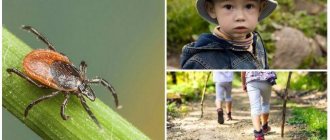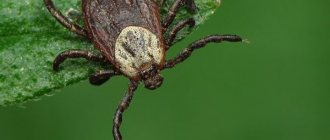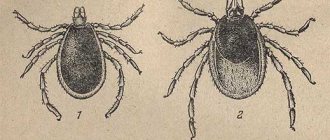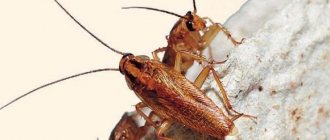Ticks are potential carriers of infectious diseases dangerous to human health. Every year, a large number of victims seek help from medical institutions. So that your vacation or trips to nature are not overshadowed, it is very important to know how to protect yourself from ticks and what to do after a bite.
A female encephalitis tick swollen with blood
Why should you be afraid of ticks and which ones?
Ticks carry deadly diseases - encephalitis and borreliosis (Lyme disease).
Tick-borne viral encephalitis (TBE) is an acute infectious viral disease that affects the central nervous system. After it, you can either recover completely, or remain disabled or even die.
Tick-borne borreliosis is an infectious disease caused by bacteria of the genus Borrelia. Manifestations of the disease are varied:
- not only the nervous system is affected, but also the cardiovascular system;
- liver;
- membranes of the brain (meningitis);
- joints;
- leather.
Ticks are not a source, but a carrier of infections. They become infected from sick animals through a bite. The tick-borne encephalitis virus is transmitted by more than 130 species of various warm-blooded wild and domestic animals and birds. Infection with tick-borne encephalitis is also possible by consuming unpasteurized milk (usually goat milk) and products made from it (cheeses, cottage cheese).
However, in addition to encephalitis and borreliosis, ticks carry 14 more diseases that are dangerous to humans:
- Q fever;
- tularemia;
- North Asian tick-borne rickettsiosis;
- human monocytic ehrlichiosis;
- human granulocytic anaplasmosis and other diseases.
But residents of Russia don’t have to bother themselves with them, just remember about encephalitis and borreliosis - the rest are practically never found in our latitudes.
In total, more than 48 thousand species of ticks are known in the world. But the carriers of diseases are the so-called ixodid ticks. This is the largest group of ticks, including 241 species. Some of the most dangerous ticks that are found in Russia are the taiga and forest ticks.
What to do if a tick has attached itself?
First you need to remove the tick. It is better not to do this yourself, but to go to a hospital or any nearby trauma center. If there is no hospital nearby, then take tweezers and treat it with an alcohol-containing solution. Gently clamp the tick as close to the proboscis as possible, holding the tweezers strictly perpendicular to the surface of the skin. Without releasing the tick, make several turns clockwise, but not sharply. The tick should come out completely. Disinfect the bite site with an alcohol-containing solution. If there is a black dot on the skin - the tick's proboscis - treat this area with 5% iodine. Even if you successfully pulled out a tick, go to the hospital as soon as possible and submit it to the laboratory to rule out viral encephalitis.
Where do ticks most often live and when are they dangerous?
If we talk about the geography of distribution, ticks that carry Lyme disease are widespread everywhere. In contrast to encephalitis ticks, which do not live in all regions of the country and not in all areas of the Moscow region.
According to Rospotrebnadzor, most often tick-borne encephalitis is registered in the North-Western, Ural, Siberian and Far Eastern regions, in the Southern Federal District - in Crimea and Sevastopol, from those adjacent to the Moscow region - in the Tver and Yaroslavl regions. On the territory of the Moscow region, encephalitis was found in ticks in the Dmitrovsky, Taldomsky and Ramensky districts, as well as in the Krylatskoye district of Moscow. Encephalitis was also found in the milk of goats from the Volokolamsk region.
Contrary to the popular stereotype, ticks do not jump on people from trees. They don't live in trees at all. They mainly live in tall grass and prefer moist, shady areas. But they can be found not only in the forest, but also in the field. A tick can attach itself in a country house, in a park, or even on a lawn in the center of Moscow. They are carried into the urban environment by dogs and birds.
It is believed that ticks are most dangerous in the spring, when they just wake up and thirst for blood. Parasites become active at air temperatures above +8 ° C and can attach themselves at any time from spring to early autumn: most often from April to September. Therefore, let’s destroy another stereotype: at the end of summer, you still shouldn’t forget about safety; in August, ticks are no less dangerous than in the spring.
Where does a tick live and where does it not exist?
Ticks do not live everywhere, and we are not only talking about areas with very cold climates. Preferred forests for these creatures are deciduous forests, for example, those where there are many birch, aspen, linden trees, as well as rowan and alder trees. Mostly these are damp lowlands, and sometimes even somewhat marshy places. In addition, ticks are very often found in mixed forests, where pine, fir, spruce, etc. grow along with deciduous trees.
On a note! But still, the main indicator of the presence of ticks will be exclusively deciduous trees!
The activity of bloodsuckers begins to gain momentum at the turn of April and May. At this time, the young, juicy grass emerging from under the leaf litter of last year is usually pleasing to the eye. It is this kind of grass that becomes the ideal place for ticks to thrive. With the onset of June, the activity of parasites begins to subside somewhat, and in July it declines even more.
Important! However, despite this, it is possible to get a tick right up to October!
If we talk about places where there are practically no ticks, then there are quite a lot of them in Russia. These are monoconiferous forests, for example, where only pine grows, as well as remote taiga areas with dense dark coniferous vegetation. There are no ticks in pine forests, where there is no undergrowth. In a word, if there are no deciduous trees in a given area, then most likely there will be no ticks there, and if there are any, then in insignificant quantities.
In addition, ticks never settle in rocky areas, as well as on mountain slopes and exposed rocks. In general, they are not attracted to high areas. These parasites are still more inclined to live in lowlands, and the greater the rise in altitude, the less common they will be. By the way, this is due not only to the lack of dampness, but also to the fact that as the altitude increases, the forest changes and the undergrowth disappears.
This is interesting! Ticks are not able to live where there are anthills. This is due to the fact that ants eat bloodsuckers when they are at a “young” age. Thus, the ticks do not even have time to grow. Therefore, if you notice an anthill, know that there should be no dangerous blood-sucking individuals in this area!
How to protect yourself from ticks while hiking
By hike we mean any outing into nature: be it sports tourism or just a picnic with friends.
The main measures to protect against ticks in any situation are proper clothing and regular inspection. The main task is to prevent the tick from sticking to the skin. If it does stick, it is important to detect it as early as possible. This will help prevent infection with Lyme disease: it is believed that if the tick was attached less than 24 hours ago, transmission of bacteria is unlikely.
However, in the case of tick-borne encephalitis virus, this rule does not work - the virus enters the blood instantly. Therefore, residents of areas unfavorable for tick-borne encephalitis, and especially those whose work involves visiting forests, are recommended to be vaccinated against this infection. There is no vaccine for Lyme disease, all you have to do is follow the prevention recommendations:
Protective clothing against ticks is one that covers the skin as much as possible. You should not be in the forest wearing open clothes and shoes. Wear light trousers, tuck them into your socks (even though this sounds terrible), choose sneakers instead of sandals and flip-flops for this walk. It is recommended to wear light-colored clothing, because insects will be more noticeable on it.
There is also special clothing that protects against the crawling of ticks - with folds that slow down their upward movement. It is believed that they can only crawl up, but this is not so - they can also go down, but it is quite possible that for some time such folds will actually hold them, and you will see them during the next inspection.
Regularly checking your skin and clothing every two hours should become a habit. The inspection should include areas where ticks are most likely to bite (because the skin is thinner there), including the armpits, groin, back of the knees, belt line and scalp. Taking a shower or bath will help identify and wash away parasites that have not yet attached to your skin.
Insulating clothing is another method that should not be neglected. The clothes you came back from outside can be placed in an electronic dryer, if you happen to have one, or in a washing machine on the drying cycle - 4 minutes is enough to kill ticks. As an alternative, you can hang clothes on the balcony, but just do not put them directly in the basket with dirty laundry, do not place them in the apartment - this can lead to the fact that ticks from the clothes get into the house and can crawl again and this time stick.
As an additional measure of protection, you can treat your clothing with repellents.
How to check your body and where ticks can crawl?
The tick can survive in the house for several days. If you notice it on your clothing, you can remove it using adhesive tape. Ticks, clinging to clothing, begin to climb up it until they reach the thin skin on the body.
The tick cannot bite on the heel, but on the groin, armpit, neck, behind the ears and on the head - it can. Therefore, when returning from a walk, you need to first examine these places. From the moment a tick latches onto clothing and reaches the skin, about an hour to an hour and a half passes, during which time you can manage to detect it and remove it.
Question answer
When to get vaccinated against tick-borne encephalitis?
Tick repellents: which ones to choose
Insect repellents containing the active ingredients DEET, IR3535, or picaridin can help prevent tick bites, but they must be reapplied regularly. Some people use traditional recipes - oil of lemon eucalyptus and citronella - but they have no proven effectiveness.
- DEET (N, N-diethyl-3-methylbenzamide) is the repellent most commonly used against ticks. In most cases, products containing 10 to 30 percent DEET are sufficient. The higher the concentration of DEET in a product, the longer it lasts. It's important to read the label to know how much DEET is in the products you use and follow the manufacturer's instructions to determine how often to reapply them.
It is worth discussing with your doctor the recommendations for using DEET in children. When used as directed, products containing DEET are safe for children over two months of age. But according to recommendations, products containing more than 30% DEET should not be used on children. In rare cases, DEET can cause hives and blisters in some adults and children, so it is best to apply the product only to clothing.
- Picaridin is another repellent that is recommended as an alternative to DEET. Unlike DEET, picaridin generally does not cause side effects and is odorless, non-sticky and non-greasy; it also does not irritate the skin, does not stain fabrics and does not destroy plastic items of clothing.
- IR3535 – may not be compatible with some synthetic materials.
- Permethrin is a pesticide that kills ticks. It can be applied to clothing, tents and bed nets (but not directly to the skin). Permethrin is not harmful to humans, although it sometimes causes swelling and redness of the skin. Permethrin can be applied to clothing by mixing a pre-measured amount of the product with water and immersing the clothing in the solution for three to four hours and allowing it to dry. It can also be sprayed directly onto clothing and allowed to dry. Clothing with permethrin embedded in the fabric is also available, the properties of which can be maintained after repeated washing (more than 60 times).
What should you not do to get a tick?
You should not jerk or try to forcefully remove the tick from the body in any other way, otherwise there is a risk that the proboscis with which it has embedded itself will remain in the skin. Even if you were not in an endemic area, you should not ignore the bite and hope that it will work out. The tick still needs to be placed in a separate sealed container and taken to a diagnostic laboratory, where they will check whether it is dangerous. If you notice a bite, but the tick is not found, after three weeks you need to be tested for antibodies to borrelia to rule out borreliosis.
Protection against ticks in a suburban area
Protective measures against ticks in the area of a country house/cottage can reduce the likelihood of contact with ticks in the open air. But personal precautions (clothing, check-ups) are still necessary.
- Clearing forest boundaries and mowing lawns . Some of the carriers of ticks are mice; they live in areas bordering forests. It is advisable to clear these areas and separate the lawn from them with a path of wood chips about a meter wide. It is also important to mow the lawn regularly: a well-trimmed and sunny lawn is less suitable for ticks than thickets of tall grass in the shade.
- Treating the area with a tick killer can reduce the local tick population; however, this approach has not been shown to reduce the number of new cases of tick-related diseases because such treatments do not prevent the introduction of new ticks.
What to do if you can’t get it yourself?
Go to a hospital or emergency room. This can be done either at your place of registration or at the nearest medical facility. Examination and removal of ticks is carried out free of charge in clinics at the place of residence or at the place of treatment if you have a compulsory health insurance policy (CHI).
How long does the encephalitis vaccine last? More details
Protection against ticks in the city
You can also find ticks in city parks, so when relaxing on the grass you must follow the same recommendations as if you were in the forest. Dog owners should be constantly on guard: it is often on dogs that blood-sucking insects enter the house, even if the animal takes anti-tick tablets. Therefore, it is also necessary to inspect animal hair after a walk.
How to remove a tick correctly? Which methods to use and why?
How to understand that you have been bitten by a tick: symptoms after a tick bite with encephalitis and Lyme disease
More about training, nutrition, sports medicine and sports as an activity - in the “Health” section
Subscribe to the Sports.ru telegram channel about health
Photo: RIA Novosti/Vladimir Fedorenko, Maxim Bogodvid, Denis Abramov; pexels.com/Erik Karits
Find out how things are going with park treatment
Ticks live on grass and low bushes. Adults cannot jump higher than 1–1.5 meters. Sometimes they parasitize birds and get onto trees with their help. Thus, you can encounter ticks in forests, fields and even park areas. If you are walking in the city, find out how often the greenery is treated for pests and parasites. This information can be found on the local government website.
If things with processing are not as rosy as you would like, keep protective equipment at the ready - we’ll talk about them later. The city gets rid of insects in a timely manner - rest assured: the likelihood that a tick will attack you while walking is low.
Best Health Posts
- How to remove a tick correctly? Which methods to use and why?
- How to understand that you have been bitten by a tick: symptoms after a tick bite with encephalitis and Lyme disease
- Even athletes die due to sudden cardiac arrest. How to understand if there is such a risk for you
- Why do autumn allergies occur? How not to confuse it with a cold?
- Why do you always want to sleep in the fall?
- Biohacking allows you to sleep 5 hours a day, get enough sleep and be effective: is this true?
- Is sleeping on the floor beneficial or not?
- How to fall asleep quickly and have a good night's sleep? Effective tips for improving sleep
Watch for signs of illness
Not all ticks are deadly, but the threat they pose cannot be ignored. Here are some signs that hint at the emergence of serious illnesses:
Circular rash
It appears with Lyme disease 3–30 days after the bite. At this point, the person may report a fever. If this symptom is not taken care of in time, the infection can spread to the joints, heart and nervous system.
Fever
Indicates possible encephalitis, especially if it appears and progresses on days 2–10. It is often accompanied by nausea, vomiting, fatigue, and sleep disturbances.











